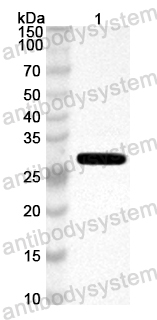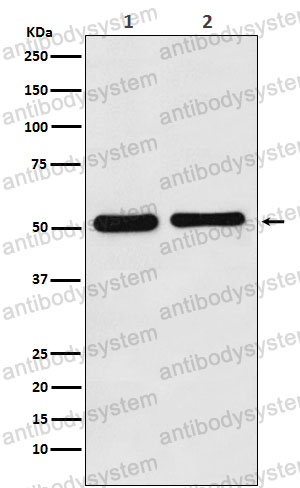Catalog No.
PMG64101
Species reactivity
Mouse
Host species
Rabbit
Isotype
IgG
Clonality
Polyclonal
Immunogen
E. coli - derived recombinant Mouse LAMB3 (Val30-Cys250).
Tested applications
ELISA: 1:4000-1:8000, IHC: 1:50-1:100, WB: 1:1000-1:4000
Target
Laminin subunit beta-3, Epiligrin subunit bata, Kalinin B1 chain, Kalinin subunit beta, Laminin-5 subunit beta, Nicein subunit beta, Lamb3
Purification
Purified by antigen affinity column.
Accession
Q61087
Applications
ELISA, IHC, WB
Form
Liquid
Storage buffer
0.01M PBS, pH 7.4, 50% Glycerol, 0.05% Proclin 300.
Stability and Storage
Use a manual defrost freezer and avoid repeated freeze thaw cycles. Store at 2 to 8°C for frequent use. Store at -20 to -80°C for twelve months from the date of receipt.
EGFR-mediated local invasiveness and response to Cetuximab in head and neck cancer., PMID:40121428
The potential crosstalk between tumor and plasma cells and its association with clinical outcome and immunotherapy response in bladder cancer., PMID:37138324
Fibulin7 aggravates calcium oxalate-induced acute kidney injury by binding to calcium oxalate crystals., PMID:36370444
Molecular and Clinical Outcomes After Intravenous Gentamicin Treatment for Patients With Junctional Epidermolysis Bullosa Caused by Nonsense Variants., PMID:35234826
Genome-wide CRISPR/Cas9 library screen identifies PCMT1 as a critical driver of ovarian cancer metastasis., PMID:35033172
Lack of K140 immunoreactivity in junctional epidermolysis bullosa skin and keratinocytes associates with misfolded laminin epidermal growth factor-like motif 2 of the β3 short arm., PMID:28561256
Expression of the Long Non-Coding RNA HOTAIR Correlates with Disease Progression in Bladder Cancer and Is Contained in Bladder Cancer Patient Urinary Exosomes., PMID:26800519
Dermal eosinophilic infiltrate in junctional epidermolysis bullosa., PMID:25950805
WNT5A inhibits metastasis and alters splicing of Cd44 in breast cancer cells., PMID:23484019
Herlitz junctional epidermolysis bullosa: diagnostic features, mutational profile, incidence and population carrier frequency in the Netherlands., PMID:21801158
TNFR and LTbetaR agonists induce follicle-associated epithelium and M cell specific genes in rat and human intestinal epithelial cells., PMID:19501526
Increase of laminin 5 synthesis in human keratinocytes by acute wound fluid, inflammatory cytokines and growth factors, and lysophospholipids., PMID:15541073
Novel and recurrent mutations in the laminin-5 genes causing lethal junctional epidermolysis bullosa: molecular basis and clinical course of Herlitz disease., PMID:15538630
Evaluation of the ARMD1 locus on 1q25-31 in patients with age-related maculopathy: genetic variation in laminin genes and in exon 104 of HEMICENTIN-1., PMID:15370542
Targeted inactivation of murine laminin gamma2-chain gene recapitulates human junctional epidermolysis bullosa., PMID:14632187
Molecular diagnostics facilitate distinction between lethal and non-lethal subtypes of junctional epidermolysis bullosa: a case report and review of the literature., PMID:12447669
Moderation of phenotypic severity in dystrophic and junctional forms of epidermolysis bullosa through in-frame skipping of exons containing non-sense or frameshift mutations., PMID:10469327
Corrective transduction of human epidermal stem cells in laminin-5-dependent junctional epidermolysis bullosa., PMID:9650620
Compound heterozygosity for an out-of-frame deletion and a splice site mutation in the LAMB3 gene causes nonlethal junctional epidermolysis bullosa., PMID:9501007
Predominance of the recurrent mutation R635X in the LAMB3 gene in European patients with Herlitz junctional epidermolysis bullosa has implications for mutation detection strategy., PMID:9242513
Immunohistochemical analysis of the skin in junctional epidermolysis bullosa using laminin 5 chain specific antibodies is of limited value in predicting the underlying gene mutation., PMID:9217810
Identification of the LAMB3 hotspot mutation R635X in a Hungarian case of Herlitz junctional epidermolysis bullosa., PMID:9209887
Compound heterozygosity for a dominant glycine substitution and a recessive internal duplication mutation in the type XVII collagen gene results in junctional epidermolysis bullosa and abnormal dentition., PMID:8669466
Genetic basis of lethal junctional epidermolysis bullosa in an affected fetus: implications for prenatal diagnosis in one family., PMID:8532625
A homozygous nonsense mutation in the alpha 3 chain gene of laminin 5 (LAMA3) in lethal (Herlitz) junctional epidermolysis bullosa., PMID:7633458
Altered laminin 5 expression due to mutations in the gene encoding the beta 3 chain (LAMB3) in generalized atrophic benign epidermolysis bullosa., PMID:7706760


